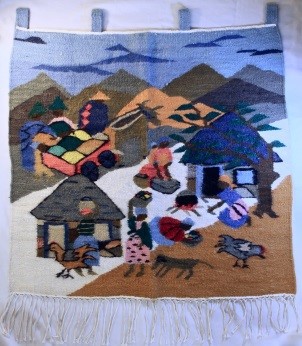Textiles are an important artform in many African cultures. While weavers in some cultures are traditionally female, as among the Basotho of southern Africa, in other cultures men traditionally do the weaving, as among the Asante of Western Coastal Africa and the Senufo of Western Africa. The weavers do use different types of looms, however; women tend to weave on upright, single-heddle looms, while men tend to weave on narrow, double-heddle looms. The textiles produced on each of these looms, however, may vary widely in style and in complexity.

Asante culture
20th century
Cotton, pigment, and wood, L. 8.5 cm x W. 6 cm x H. 21.5 cm
BFPC collection #2013.19
This female figurine is wearing a traditional wrapped dress that is printed to resemble traditionally woven Kente cloth with red, black, green, and yellow geometric designs. Originally Kente cloth, with its difficult-to-obtain dyes and elaborately woven designs, was made only for royalty. However, as imported rayon thread in bright colors and printed cloth became widely available, Kente-style cloth became available to commoners. Today Kente has become a symbol of the country of Ghana, where the Asante live. Researched by Hannah Woolridge

Asante culture
20th century
Cotton thread and pigment, L. 1.55 m x W. 11 cm x H. 5 mm
BFPC collection #2018.1a
This long, narrow strip of Kente cloth provides a good illustration of how Kente cloth is made. Strips such as this are woven individually on narrow looms, and then these strips are sewn together to make a large piece of fabric. As the strips vary in design, this creates a complex geometric pattern and a dazzling overall effect. The individual motifs on Kente cloth can also have specific meanings, and several of the motifs on this strip are identifiable: The pattern of vertical lines and dots is called nwatoa, or snail’s bottom, while the white-on-blue shapes that come to a point are called secan, or knife. Researched by Hannah Woolridge

by Helang Basali Weavers
Basotho culture
20th century
Mohair on cotton and pigment, L. 1.005 m x W. 84 cm x H. 7 mm
Reid collection #2018.2
This tapestry was created by the female Basotho weavers of Teya Teyaneng in the country of Lesotho, in southern Africa. While weaving has a long tradition among the Basotho, tapestry weaving was introduced in the 1960s. Lesotho is the world’s fourth largest producer of mohair, or goat’s wool, which provides ready materials for making tapestries, and women were quick to embrace making mohair rugs and wall hangings. As on this tapestry, the weavers design the wall hangings and rugs with scenes of daily life from their rural villages: A woman cooks over an open fire, another woman carries a basket on her head, another grinds grain while carrying a child on her back, and chickens and dogs interact with the figures. Researched by Hannah Woolridge

by ‘Matsepang of Helang Basali weavers
Lesotho culture
20th century
Mohair on cotton and pigment, L. 1.64 m x W. 36.5 x H. 7 mm
Reid collection #2018.1
This long weaving was created by ‘Matsepang of the Helang Basali weavers, a Basotho weaving workshop in the country of Lesotho. The tapestry is rendered in stacked panels with three different scenes. Above and below each of the three larger panels is a border depicting from two to four white birds. The top panel shows three young boys who are running or dancing, and the center panel shows three young men in traditional initiation dress, with a dog walking beside them. The bottom panel depicts two women in patterned skirts who are carefully carrying vessels on their scarf-wrapped heads. As such weaving mixes non-traditional materials and methods—in this case, goat’s wool and tapestry weaving—with traditional themes and styles, such as typical images from the rural communities, this is a type of international art. Researched by Hannah Woolridge

Senufo culture
20th century
Natural fiber and pigment, L. 39.5 cm x W. 11.5 cm x H. 5 mm
BFPC collection #2015.3
This strip of cloth was created by the male weavers of the Senufo culture of Côte d’Ivoire. Strips of cloth are woven individually on a narrow loom, and the strips are sewn together to make a larger cloth. The cloths are then made into spiritually protective clothes for hunters. The bird on this strip of cloth may represent a water-feeding bird, as these birds are seen as great hunters. Researched by Hannah Woolridge
For more information, you may contact the researcher(s) noted in the title of this exhibit entry, or Dr. Billie Follensbee, the professor of the course, at BillieFollensbee@MissouriState.edu
